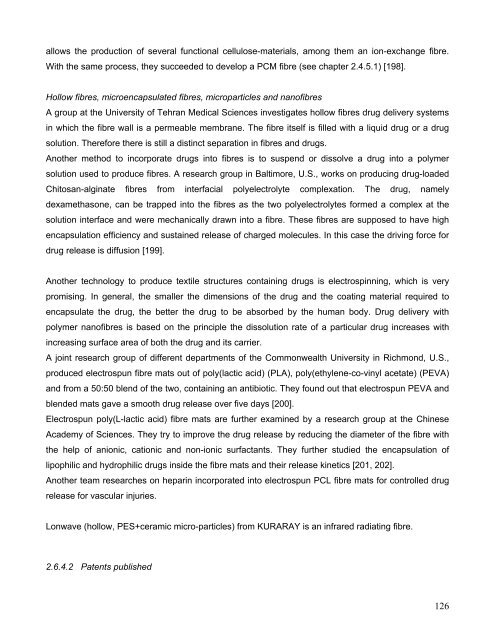Clevertex - Grado Zero Espace Srl
Clevertex - Grado Zero Espace Srl
Clevertex - Grado Zero Espace Srl
You also want an ePaper? Increase the reach of your titles
YUMPU automatically turns print PDFs into web optimized ePapers that Google loves.
allows the production of several functional cellulose-materials, among them an ion-exchange fibre.<br />
With the same process, they succeeded to develop a PCM fibre (see chapter 2.4.5.1) [198].<br />
Hollow fibres, microencapsulated fibres, microparticles and nanofibres<br />
A group at the University of Tehran Medical Sciences investigates hollow fibres drug delivery systems<br />
in which the fibre wall is a permeable membrane. The fibre itself is filled with a liquid drug or a drug<br />
solution. Therefore there is still a distinct separation in fibres and drugs.<br />
Another method to incorporate drugs into fibres is to suspend or dissolve a drug into a polymer<br />
solution used to produce fibres. A research group in Baltimore, U.S., works on producing drug-loaded<br />
Chitosan-alginate fibres from interfacial polyelectrolyte complexation. The drug, namely<br />
dexamethasone, can be trapped into the fibres as the two polyelectrolytes formed a complex at the<br />
solution interface and were mechanically drawn into a fibre. These fibres are supposed to have high<br />
encapsulation efficiency and sustained release of charged molecules. In this case the driving force for<br />
drug release is diffusion [199].<br />
Another technology to produce textile structures containing drugs is electrospinning, which is very<br />
promising. In general, the smaller the dimensions of the drug and the coating material required to<br />
encapsulate the drug, the better the drug to be absorbed by the human body. Drug delivery with<br />
polymer nanofibres is based on the principle the dissolution rate of a particular drug increases with<br />
increasing surface area of both the drug and its carrier.<br />
A joint research group of different departments of the Commonwealth University in Richmond, U.S.,<br />
produced electrospun fibre mats out of poly(lactic acid) (PLA), poly(ethylene-co-vinyl acetate) (PEVA)<br />
and from a 50:50 blend of the two, containing an antibiotic. They found out that electrospun PEVA and<br />
blended mats gave a smooth drug release over five days [200].<br />
Electrospun poly(L-lactic acid) fibre mats are further examined by a research group at the Chinese<br />
Academy of Sciences. They try to improve the drug release by reducing the diameter of the fibre with<br />
the help of anionic, cationic and non-ionic surfactants. They further studied the encapsulation of<br />
lipophilic and hydrophilic drugs inside the fibre mats and their release kinetics [201, 202].<br />
Another team researches on heparin incorporated into electrospun PCL fibre mats for controlled drug<br />
release for vascular injuries.<br />
Lonwave (hollow, PES+ceramic micro-particles) from KURARAY is an infrared radiating fibre.<br />
2.6.4.2 Patents published<br />
126

















